| March 28, 1996 | |
| These false-color CCD images were taken on 1996 Mar. 28 in moonlight conditions, using the short focus lens and narrow-band filters. | |
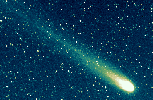
|
Wide-field image of comet Hyakutake, taken on 1996 Mar. 28, with the 2.8/90mm lens, CCD and narrow-band H2O+ filter, centered at 620nm (FWHM=10nm).
Exposure time was 5 minutes, starting at 19:49:48UT. The frame field of view is 7.5x5.0deg.
(Size 144K) |
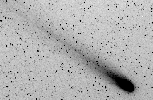
|
B-W negative of the above image.
(Size 105K) |
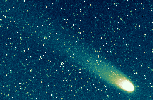
|
Wide-field image of comet Hyakutake, taken with the 2.8/90mm lens, CCD and dust continuum filter, centered at 647nm (FWHM=10nm).
Exposure time was 5 minutes, starting at 19:56:21UT.
(Size 142K) |
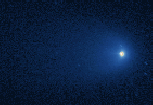
|
B.Dintinjana took this 3-minute image of inner coma structure with the 4.5/300mm lens, MCD1600 CCD and photometric R filter on 1996 Mar. 28, at the University of Ljubljana Astronomical Observatory.
Exposure started at 23h46UT. Note the narrow plasma jet and dust hooks.
(Size 75K) |
| March 27, 1996 | |
|
See the historical views of comet Hyakutake, passing near the Polaris in early morning of Mar. 27th. These images were taken by Herman Mikuz and Bojan Kambic from a dark site at Slovenske Gorice, 170km east of Slovene capital Ljubljana. On otherwise cloudy Central Europe, the weather satellite shows a small gap approaching to NE Slovenia. We traveled to this distant site and indeed enjoyed a 3-hr clear period. We were both impressed due to the splendid Hyakutake display. With the naked eye the tail spanned for 45 deg, up to Beta CVn and the estimated comet m1 was 0.4 magnitude. All images were guided on comet nuclear condensation. |
|
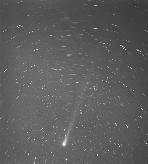
|
Wide-field view of comet Hyakutake passage near the Alpha UMi was taken on 1996 Mar. 27 (1h03-1h25UT) with the 3.5/65mm lens and T-Max 400 film (6x6 format).
The field size is ~40x35 deg. The tail length is about 30 deg. The constellation of Ursa Major is visible on the upper part of picture.
(Size 65K) |
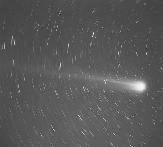
|
Wide-field view of comet taken on 1996 Mar. 27 (2h01-2h22UT) with the 3.5/250mm lens and T-Max 400 film (6x6 format). The field size is ~12x10 deg.
(Size 25K) |
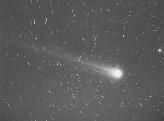
|
Wide-field view of comet Hyakutake taken on 1996 Mar. 27 (2h57-3h15UT) with the 3.5/250mm lens and T-Max 400 film (6x6 format).
The field size is ~12x10 deg. Polaris is the brightest star on the picture.
(Size 50K) |
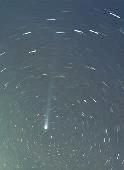
|
Wide-field view of comet Hyakutake taken on 1996 Mar. 27 (2h01-2h31UT) with the 3.5/20mm lens and Fujicolor G-400 color negative film.
(Size 38K) |
| You may choose also the high resolution image (186K). | |

|
True-color image of comet Hyakutake taken on 1996 Mar. 27 (0h33-0h53UT) with the 3.5/250mm lens and Fujicolor G-400 color negative film. The field size is ~8x5.5 deg.
(Size 23K) |
| You may choose also the high resolution image (186K). | |

|
True-color image of comet Hyakutake taken on 1996 Mar. 27 (1h03-1h25UT) with the 3.5/250mm lens and Fujicolor G-400 color negative film. The field size is ~8x5.5 deg.
(Size 22K) |
| You may choose also the high resolution image (186K). | |
| March 20-21 1996 | |
| Series of images were taken on the night of 1996 Mar. 20-21 from the Crni Vrh Observatory in very good conditions. Of special interest are mosaic images displaying the complex ion tail structure with rays, knots and clouds of singly ionized water moleculas. The ion tail total length on 65mm f.l. images is about 20 degrees. Additional monitoring with red continuum filter shows only featureless ~7 deg broad tail. | |

|
This true color image of comet was taken on 1996 Mar. 21 (1h43-2h03UT) with the 20-cm, f/2 Baker-Schmidt camera and Fujicolor G-400 color negative film. The field size is ~3.4x5.0 deg.
Turn off the lights in your room and enjoy the comet display in real colours!
(Size 319K) |

|
Wide-field mosaic image of comet Hyakutake, recorded in the light of singly-ionized water ions was taken on 1996 Mar. 20, with the 2.8/180mm lens, CCD and narrow-band H2O+ filter, centered at 620nm (FWHM=10nm).
Each frame was exposed for 10 minutes, centered at 23h37UT. The image FOV (field of view) is 6.6x2.4 deg.
(Size 272K) |
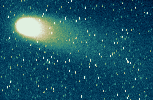
|
See also the dust continuum image, obtained with the 2.8/180mm lens and narrow-band filter centered at 647nm (FWHM=10nm).
Exposure time was 10 minutes, starting at 22:40:31UT. The image FOV is 3.8x2.5 deg.
(Size 147K) |
|
|
Wide-field mosaic image of comet Hyakutake, recorded in the light of singly-ionized water ions was taken on 1996 Mar. 21, with the 3.5/65mm lens, CCD and narrow-band H2O+ filter, centered at 620nm (FWHM=10nm).
Each frame was exposed for 15 minutes, centered at 2h12UT. The image FOV is 19.0x5.1deg.
(Size 140K) |
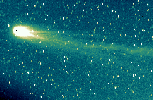
|
Wide-field image of comet Hyakutake, taken on 1996 Mar. 21, with the 2.8/90mm lens, CCD and narrow-band H2O+ filter, centered at 620nm (FWHM=10nm).
Exposure time was 15 minutes, starting at 3:09:46UT. The image FOV is 7.5x5.0deg.
(Size 140K) |
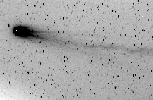
|
B-W negative of the previous image.
(Size 101K) |
| March 19, 1996 | |
| Two images were taken on 1996 Mar. 19 from the Crni Vrh Observatory station at Miren in rather poor conditions, through the thin cirrus clouds. Nevertheless, the complex tail structure is well recorded on the H2O+ frame. | |
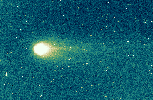
|
CCD image of comet Hyakutake, recorded in the light of singly-ionized water ions, taken on 1996 Mar. 19, with the 4.0/250mm lens and narrow-band H2O+ filter, centered at 620nm (FWHM=10nm).
Exposure time was 5 minutes, starting at 2:07:19UT. The image FOV (field of view) is 163'x107'.
(Size 164K) |
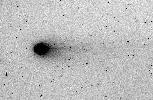
|
B-W negative of the previous image.
(Size 47K) |

|
CCD image of comet Hyakutake, taken on 1996 Mar. 19, with the 4.0/250mm lens and dust continuum filter, centered at 647nm (FWHM=10nm).
Exposure time was 3 minutes, starting at 2:38:34UT. The image FOV is 163'x87'.
(Size 118K) |